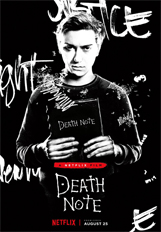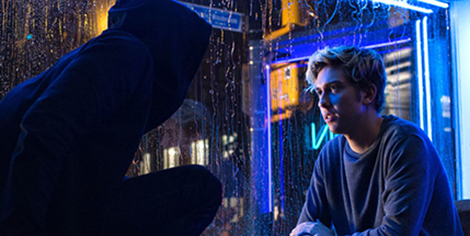Death Note (2017)
| Directed By: | Adam Wingard |
| Written By: | Charley Parlapanides |
| Vlas Parlapanides | |
| Jeremy Slater | |
| Starring: | Nat Wolff |
| Lakeith Stanfield | |
| Margaret Qualley | |
| Shea Whigham |

Now I can’t proclaim to be the biggest fan of the Death Note anime – it was only when I realised that Netflix was picking it up to reboot as a feature film that I decided I’d sit down and force myself through it – but, that being said, it’s hard to disassociate one from the other.
I’ll be the first to admit that the anime isn’t without its problems; both the protagonist and antagonist are insufferable beyond measure, and there’s all sorts of bizarre leaps of logic that the anime goes through that you just sort of need to deal with…that being said, however, I’d never thought I’d actually miss them. Problems though they may be, they are a part of what makes Death Note Death Note, and unfortunately, in addressing them, Adam Wingard’s reboot comes across as merely a santisied, Westernised version of it.
Anyway, I’m getting a little ahead of myself. Death Note follows the story of high schooler Light Turner (Nat Wolff), after a notebook providing its user with the power to kill anyone he desires – bar a few rules – literally falls into his hands. Initially using his power for good, it’s not long (and, with the amount of story Wingard has compressed into the film’s hour-and-a-half runtime, I really mean ‘not long’), before Light, under the pseudonym Kira – operating along with his along-for-the-ride girlfriend Mira (Margaret Quailey) – develops somewhat of a god complex as he begins to gather doting fans from around the world, all eager to see him continuing to punish criminals. Soon, he catches the eye of enigmatic detective L (Lakeith Stanfield), who vows to uncover the identity of Kira and bring him to justice.

The well-discussed issues of whitewashing aside, the primary problem I have with Wingard’s Death Note is that it’s simultaneously – paradoxically – too similar and too different from the original anime. In the anime, Light and L were both geniuses, completely on top of their games. Intolerable as they may be, it was an interesting game of cat-and-mouse between them as they both battled to outsmart each other. However, film Light is far from the popular-yet-arrogant anime Light; he’s unpopular, quiet and reserved. Consequently, the resulting conflict between Light and L is watered down far too much; gone is the finale’s battle of wits between two people convinced that they are the intellectual superior, and instead we are treated to a twenty-minute long action sequence. As much as I sound like an anime purist, a great deal of the tension – and the fun – of the anime came from the sense that the noose was tightening on Light as L steadily uncovered more and more about the mysterious Kira. Instead, in the film, rather than operating in the shadows to secure his safety, L confronts Light halfway through the film, and accuses him of behind behind all the murders that have been taking place. Had Wingard decided to tell a different Death Note story with different characters, this may have been more forgivable, but by naming his characters Light and L, he is acknowledging that the film and the anime are essentially one and the same. This is where my problem lies; Wingard hasn’t made enough changes to his film to allow it to stand on its own two feet, so consequently it’s hard to extricate the two from each other…and yet has made just enough changes to make it seem like a diluted imitation.
Setting aside the breakneck speed at which it runs, it’s tonally a little odd too, and nothing epitomises this more the scene in which we are introduced to Ryuk. Sat alone in a classroom, Light becomes aware of some movement behind him, and goes to investigate. After cautiously venturing forward, a shadowy bespiked figure emerges from the shadows; the death god guardian of the notebook, Ryuk. What follows is what can only be described as pantomime, as about thirty seconds pass of Light letting out a series of high-pitched screams as various bits of furniture go flying around him. And what makes it all the weirder is that Ryuk himself, instead of being the eternally bemused comic relief of the anime, is instead a much more sinister figure, largely relegated to the shadows. A scene that was played out with complete sincerity in the anime becomes farcical whilst at the same time, a character that was largely played for laughs becomes a great deal more ominous. It’s jarring to say the least.
I admit, I’m being super critical here. It’s not all bad; as with most of Wingard’s films it’s as stylish as hell, there are some pretty spectacular setpieces and Willem Defoe with his gravelly voice was born to play Ryuk. Ultimately, it’s still fun – especially some of the earlier death scenes that play out in a Final Destination sort-of way – and definitely something I believe people unfamiliar with the anime would perhaps enjoy more than those who are. It’s just a shame I wasn’t one of those people.
Rating: 














